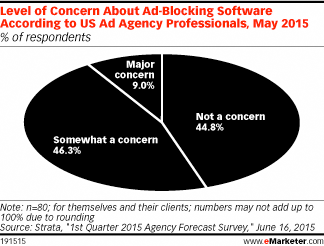Ad Blocking: A Growing Audience, but Little Advertiser Panic—Yet
August 15, 2015
![]() Thanks to ad-blocking technologies, many of the web’s most informed and devoted users have a very different internet experience than the ones marketers and publishers have built: no display or pre-roll video ads, no retargeted ads and, in many cases, no native ad content. Although ad blocking’s effects on advertising and publishing profits have been minimal, this could change quickly if blocker adoption becomes more widespread, according to a new eMarketer report, “Digital Ad Blocking: Will Escalating Usage Imperil Marketing, Monetization Efforts?”
Thanks to ad-blocking technologies, many of the web’s most informed and devoted users have a very different internet experience than the ones marketers and publishers have built: no display or pre-roll video ads, no retargeted ads and, in many cases, no native ad content. Although ad blocking’s effects on advertising and publishing profits have been minimal, this could change quickly if blocker adoption becomes more widespread, according to a new eMarketer report, “Digital Ad Blocking: Will Escalating Usage Imperil Marketing, Monetization Efforts?”
 Because the available data is relatively scant and rather divergent, eMarketer does not have an official estimate for the number of internet users who block ads. However, a data comparison suggests it is reasonable to assume that roughly 10% to 15% of US internet users are actively blocking digital ads, with a higher proportion of younger demographics doing so.
Because the available data is relatively scant and rather divergent, eMarketer does not have an official estimate for the number of internet users who block ads. However, a data comparison suggests it is reasonable to assume that roughly 10% to 15% of US internet users are actively blocking digital ads, with a higher proportion of younger demographics doing so.
 PageFair remains the source of most estimates of the ad-blocker user base. The firm partnered with Adobe in 2014 and 2015 to produce a survey of the ad-blocking landscape, estimating that 4.9% of internet users worldwide, or 144 million per month, were using ad-blocking software in Q2 2014, a nearly 70% year-over-year increase. The number of ad-block users worldwide rose to 198 million by June 2015, according to the August 2015 version of PageFair/Adobe report, equal to 6% of all internet users. The US contributed 45 million to the total, equal to 16% of US internet users.
PageFair remains the source of most estimates of the ad-blocker user base. The firm partnered with Adobe in 2014 and 2015 to produce a survey of the ad-blocking landscape, estimating that 4.9% of internet users worldwide, or 144 million per month, were using ad-blocking software in Q2 2014, a nearly 70% year-over-year increase. The number of ad-block users worldwide rose to 198 million by June 2015, according to the August 2015 version of PageFair/Adobe report, equal to 6% of all internet users. The US contributed 45 million to the total, equal to 16% of US internet users.
 June 2015 figures from the Reuters Institute for the Study of Journalism at the University of Oxford suggest an even higher overall number are using ad blocking in the US: 41% of PC users and 11% of mobile users reported regularly using ad-blocking software, and usage rates in the UK weren’t far behind.
June 2015 figures from the Reuters Institute for the Study of Journalism at the University of Oxford suggest an even higher overall number are using ad blocking in the US: 41% of PC users and 11% of mobile users reported regularly using ad-blocking software, and usage rates in the UK weren’t far behind.
The PageFair/Adobe 2015 survey found usage rates varied from approximately 9% to 38% in the European countries it examined. Greece and Poland led the list, with 37.5% and 34.9% of internet users, respectively, using ad-blocking technology. Usage was lowest in Slovakia (8.9%) and France (10.3%).
These estimates posit a world where large shares of internet users actively utilize ad-blocking software in their digital lives. Yet at the moment, at the aggregate level, digital advertising’s status quo appears safe. Agencies, brands and ad networks have been largely insulated from any major disruption of activity so far. Although some percentage of internet users have made themselves unreachable to ads, their absence hasn’t necessarily hurt the digital advertising ecosystem.
In a May 2015 survey by Strata, 44.8% of US ad agency professionals said ad-blocking software was not a concern for their agency or clients. Only 9% described it as a major concern, while 46.3% said it was somewhat a concern. Furthermore, 88.1% said ad blocking had had only a slight or no impact on ad spending.
At more granular levels, however, ad blocking is being felt much more depending on a site’s demographic base, geographic mix and content.
“This is a vertical issue right now, [especially] with gaming and tech. Both attract audiences with more savvy types of users and a general abhorrence to advertising,” said Jonathan Mendez, founder and CEO of Yieldbot. “On a consumer-focused site, like food, you’ll see very little [ad blocking], though the trend is generally upward for most sites. Our client with the biggest block rate is at 15%, which is up from 7% nine months ago.”
PageFair’s data showed upward of a quarter of visitors worldwide to some website types used ad-blocking software when visiting those locations, led by gaming sites at nearly 27%.
Courtesy of eMarketer





























